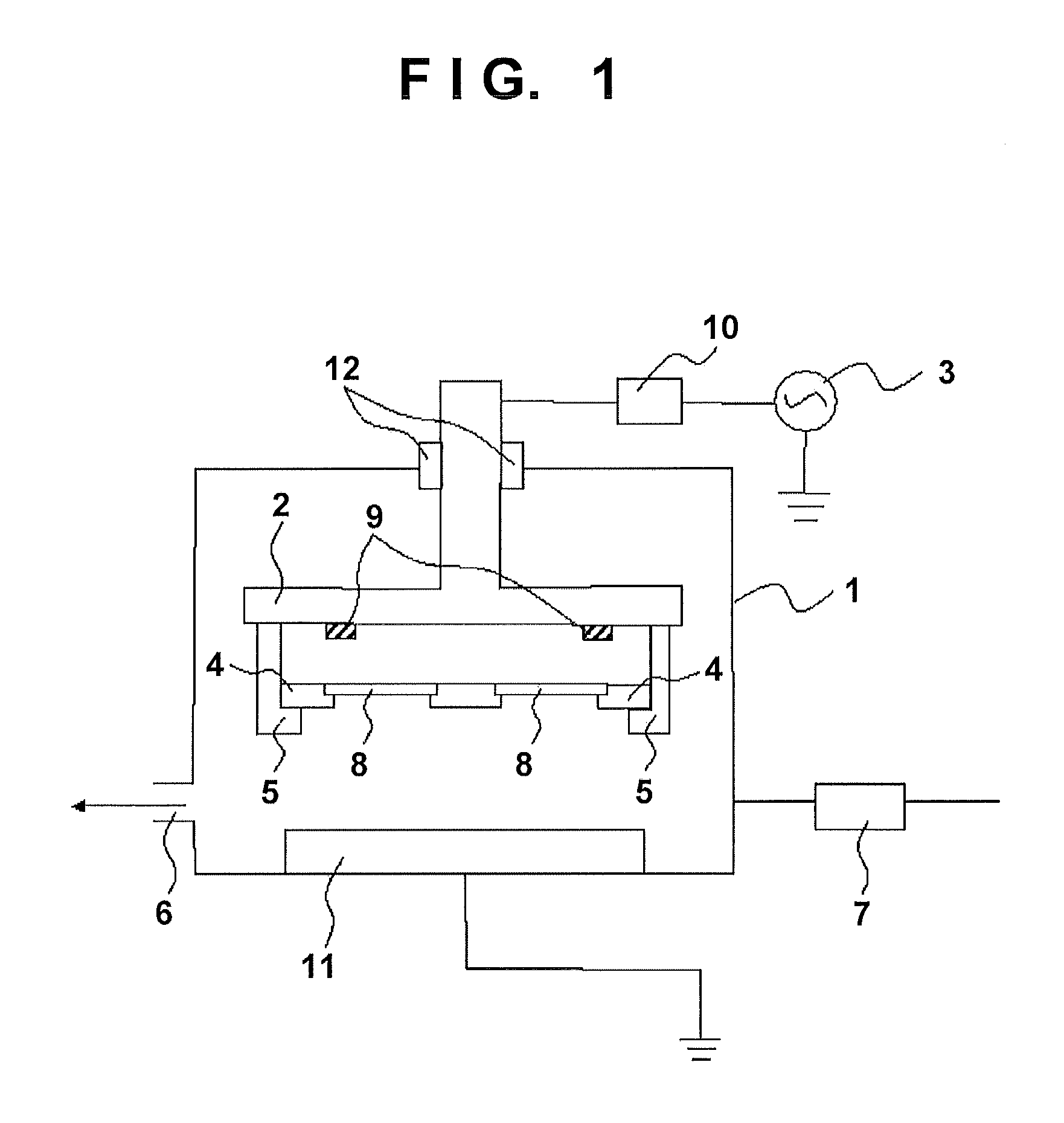Etching apparatus
a technology of etching apparatus and etching tube, which is applied in the direction of electrical apparatus, electric discharge tube, basic electric elements, etc., to achieve the effect of reducing the depth of etching
- Summary
- Abstract
- Description
- Claims
- Application Information
AI Technical Summary
Benefits of technology
Problems solved by technology
Method used
Image
Examples
first embodiment
[0050]FIG. 1 is a schematic sectional view of a first etching apparatus according to the first embodiment. As shown in FIG. 1, the first etching apparatus includes, as main constituent elements, a chamber 1 capable of evacuation and a first electrode 2 to which power is applied. In addition, the etching apparatus includes a power supply 3 for applying power required for an etching process to the first electrode 2. In the chamber 1, the first electrode 2 including clamps 5 (members made of a metal compound such as alumina) which hold a tray 4 (for example, a member made of a metal compound such as alumina) holding substrates 8 is mounted through an insulator 12 (for example, a resin such as Teflon®). The insulator 12 is a member which electrically insulates the chamber 1 and the first electrode 2. The first electrode 2 includes a tray support portion capable of supporting the outer peripheral edge portion of the tray 4. The tray 4 can hold a plurality of substrates 8, and can be load...
second embodiment
[0054]FIG. 3 is a schematic sectional view of a first electrode 2 according to the second embodiment. The basic arrangement is the same as that in the first etching apparatus. As shown in FIG. 6, a tray 4 holds four substrates at equal angular intervals around the center of the tray 4. In the second embodiment, as shown in FIG. 4, it is possible to improve the nonuniformity of an etching distribution in the radial direction of each substrate by attaching dielectric plates 9 along the peripheral edge portion of the obverse surface of a first electrode 2 so as to face the peripheral edge portions of the non-target surfaces of the four substrates provided on the peripheral portion of the tray 4. In the second embodiment, the first electrode 2 serves as the upper electrode (a second electrode 11 (not shown) serves as the lower electrode). When, however, the first electrode 2 serves as the lower electrode (the second electrode 11 (not shown) serves as the upper electrode), this embodimen...
third embodiment
[0055]FIG. 7 is a schematic sectional view of a first electrode according to the third embodiment. The basic arrangement of the third embodiment shown in FIG. 7 is the same as that of the etching apparatus in FIG. 1 described above. As shown in FIG. 11, a tray 4 holds a first substrate in the center of the tray 4, and at least four second substrates at equal angular intervals around the center of the tray 4. The tray 4 shown in FIG. 11 is provided with a plurality of substrate accommodation holes 41a, 41b, 41c, 41d, and 41e extending through the tray 4 in the thickness direction of substrates 8, and substrate holding portions 42a, 42b, 42c, 42d, and 42e capable of holding the entire peripheral edge portions of the substrates 8. The substrate holding portions 42a, 42b, 42c, 42d, and 42e each may be provided so as to be capable of holding a part of the peripheral edge portion of the substrate 8. When holding the tray 4 with a first electrode 2 (upper electrode), it is preferable to us...
PUM
| Property | Measurement | Unit |
|---|---|---|
| voltage | aaaaa | aaaaa |
| thickness | aaaaa | aaaaa |
| structure | aaaaa | aaaaa |
Abstract
Description
Claims
Application Information
 Login to View More
Login to View More - R&D
- Intellectual Property
- Life Sciences
- Materials
- Tech Scout
- Unparalleled Data Quality
- Higher Quality Content
- 60% Fewer Hallucinations
Browse by: Latest US Patents, China's latest patents, Technical Efficacy Thesaurus, Application Domain, Technology Topic, Popular Technical Reports.
© 2025 PatSnap. All rights reserved.Legal|Privacy policy|Modern Slavery Act Transparency Statement|Sitemap|About US| Contact US: help@patsnap.com



